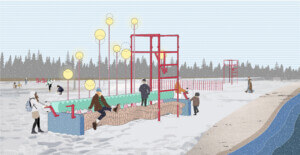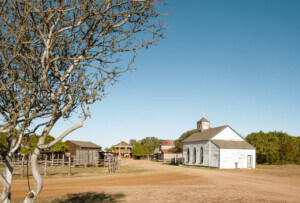In 2009, vandals pushed a dump truck through a hole in the wall on the fourth story of the abandoned Packard Automotive Plant in Detroit. (Of course there’s a video.) It’s a level of dereliction and decay that’s frankly common to North America’s foremost basket-case city, but it’s made a bit more poignant by the fact that the plant (built in 1907 and closed in the late ’90s) was once an icon of Detroit’s command over automotive technology and the automotive industry. The 3.5-million-square-foot facility was designed by Albert Kahn to produce luxury cars, and was the first of its type to use a reinforced concrete structure.
But now it’s time for some more creative thinking about how to use the Packard site, beyond inventive ways to project giant pieces of refuse out of windows. As such, Parallel Projections released the winners of an ideas competition to adaptively reuse the site on Friday. The competition (the first one Parallel Projections has hosted) garnered 200 entries from 30 countries. The three winners received $3,000, $2,000, and $1,000, respectively, and six Honorable Mentions were named. Called Reanimate the Ruins, Parallel Projections founder Kyle Beneventi said that, beyond adding another chapter to the history of a building that’s forced the carry the symbolic weight of the city’s struggles, he wants the competition to show how design can address social and economic problems. “We hope to act as a catalyst, and put these ideas in front of decision-makers to raise awareness about how design can address these issues,” he said.
The site is currently owned by Peru-based developer Fernando Palazuelo, who has his own plans for the site, though Beneventi says proposals from the ideas competition can be complimentary to his efforts, and that he’s been working with Palazuelo’s company, Arte Express.
The competition winners range from pragmatic land-use proposals to loose thought experiments. The winners are:
1st Place
Cross the Plant by Vincent Lavergne is based on one simple programmatic shift: Turn much of the factory into housing, provide financial incentives for residents in unsustainably depopulated neighborhoods to move in, thus freeing up more land for urban agriculture.
2nd Place
The Packard Belt by Javier Galindo crisscrosses the plant with a car-path belt, inspired by automotive engine belts. It’s a slow, nostalgic ride through Detroit history—a sort of a linear museum you experience while driving.
3rd Place
Ecological Engineering Center Detroit by Toni Yli-Suvanto installs a waste recycling, urban agriculture, and power generation facility on the site. Sewage treatment yields biogas, power is harvested from the sun, hydroponic plants are grown, and water is recycled.
Honorable Mention
Higher Calling: A Spiritual Mycoremediation Corridor for Detroit by Tak Stewart, Arnulfo Ramirez, and Giselle Altea recruits monks to remediate the site’s polluted soil with mushrooms via mycoremediation, using fungi to degrade or absorb contaminants.
Honorable Mention
Packard City by Bastian Gerner and Pola Rebecca Koch is an open-ended series of templates for ways to repurpose the factory’s buildings.
Honorable Mention
Urban Paradox: Architectural Iteration to Paranoiac Tensions by Chun Shing Tsui develops a hub for Detroit’s newest, saddest industry: scrap metal recovery. In an effort to tempt car companies back to the city of Detroit, this design proposes an organ that aids the city in cannibalizing itself.
Honorable Mention
Packard [Model D]etroit by Dominic Walbridge, Michael Miller, and Yan Ding divides the site into light manufacturing and fabrication areas, office space, a museum, and leisure and retail space.
Honorable Mention
Hollow Ground: Reconceiving Packard as an Urban Archipelago by Samaa Elimam and James Leng begins by renovating the site’s most recognizable buildings and converting them with strong geometric shapes into education and cultural spaces.
Honorable Mention
Augmented Chassis by Jason Butz and Akshita Sivakumar augments the physical infrastructure of the factory with smart-phone enabled “augmented reality” applications that overlay historical imagery as well as potential future renovations into museum and exhibition spaces.










